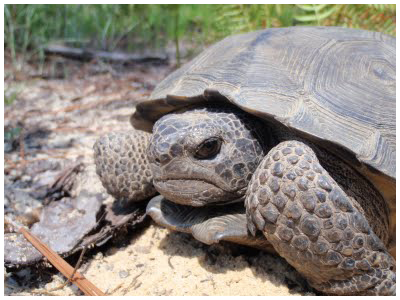
Did you know a gopher tortoise burrow provides a home for hundreds of other species?
A new draft of the five-year update to the Gopher Tortoise Management Plan for the state is available for review. The Florida Fish and Wildlife Conservation Commission (FWC) is asking for public input.
The threatened gopher tortoise is classified as a keystone species, because its extensive burrows offer shelter to more than 350 other species such as the federally threatened eastern indigo snake. Gopher tortoises were identified more than 235 years ago by naturalist William Bartram as he explored Florida.
“Gopher tortoise burrows average 6.5 feet deep and 15 feet long, provide a home for hundreds of other species and offer great amenities: constant temperature, refuge from fires and bad weather, and protection from predators,” said Deborah Burr, the FWC’s gopher tortoise plan coordinator. “When gopher tortoises decline, so do the occupants of their burrows, such as indigo snakes, gopher frogs and burrowing owls.
“The revised draft Gopher Tortoise Management Plan for the first time addresses the total picture of the tortoise and its tenants,” Burr said.
The draft plan and link to comment on the plan are available at MyFWC.com/GopherTortoise. Public comment will be accepted on the draft plan through June 25. More than 100 individuals and stakeholders already have made suggestions on improving the original 2007 plan, through written input and a public meeting.
The draft revisions to the Gopher Tortoise Management Plan are scheduled to go before the FWC’s Commissioners at their Sept. 5-6 meeting.
The objectives of the draft plan are:
• Minimize loss of gopher tortoises by ensuring humane, responsible relocation from lands slated for development;
• Increase and improve species’ habitat;
• Enhance and restore populations where the species no longer occurs or has been severely depleted;
• Maintain its function as a keystone species by also conserving commensal species.
Florida’s first Gopher Tortoise Management Plan was approved by the FWC in 2007 and was scheduled to be updated five years later.
Under the original plan, Florida has made progress in slowing the decline of gopher tortoises by providing options to move tortoises off lands slated for development as well as opportunities for homeowners and landowners interested in conserving tortoises on their property.
Since 2007, the plan has restored and managed an annual average of 36,000 acres of gopher tortoise habitat, expanded protected tortoise habitat by more than 6,500 acres, and humanely relocated than 4,000 gopher tortoises from development sites to public and private properties that afford the species long-term conservation.
Stakeholders in the Gopher Tortoise Technical Assistance Group were instrumental in the development and implementation of the Gopher Tortoise Management Plan and continue to provide input during the plan’s revision process. Assistance group representatives come from a wide range of interests: industry, conservation, land development, state and local government, universities and research, commercial services, private landowners, large federal and state land managers, animal advocacy and the general public.
In Florida, it is illegal to harm gopher tortoises or their burrows.
